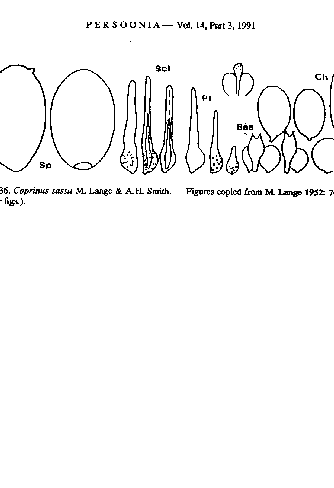Macroscopic features |
Closed pileus up to 20 mm high, narrowly conical, up to 35 mm in diam. when expanded, cinnamon-brown, red-brown, young specimens with somewhat purple tinge at centre. Lamellae free or almost free, whitish, finally black; L = c. 28. l = 0-1. Stipe up to 80 x 2-3 mm, white or weakly tinged with colour of pileus at base, pubescent. |
Microscopic features |
Spores 12.8-20.0 x 7.9-11.0 µm, av. L = 15.2-17.3, av. B = 8.7-9.8 µm, av. Q = 1.70-1.75, ellipsoid; germ pore eccentric, c. 2.5 µm wide. Basidia 18-38 x 9-12.5 µm, 2-spored. Pseudoparaphyses not mentioned. Cheilocystidia 20-60 x 20-30 µm, globose to ovoid. Pleurocystidia 50-90 x 25-55 µm, mostly vesiculose. Pileocystidia 30-100 x 5-16 µm, with tapering neck, 2-5 µm wide at apex. Sclerocystidia present. Clamp-connections present (single-spore mycelia with and without clamps, sensu Lange & Smith l.c.). |
Habitat |
Gregarious on horse-dung and decaying straw. Not known from the Netherlands (the record mentioned by Arnolds & al., 1984: 67, concerns an other species). |
Remarks |
This species is unknown to us and we did not study the type. Therefore, the description above is based on that given by Lange & Smith l.c. On account of the very large spores formed on two-spored basidia, the presence of pleurocystidia and clamp-connections and its habitat on dung C. sassii seems to be a well-defined species. Coprinus bisporus has no pleurocystidia, no clamps and much smaller spores. Coprinus bisporiger has pleurocystidia, but no clamp-connections, smaller spores too and its habitat is not on dung. The other two-spored species in subsect. Setulosi have lageniform cheilocystidia. Comparing C. sassii with 4-spored species, C. ephemerus seems to be close to it, but in that species the absence of sclerocystidia and the smaller spores are differentiating characters. |

[Copyright © by M. Lange, Dansk Botanisk Arkiv 14: 91. 1953]